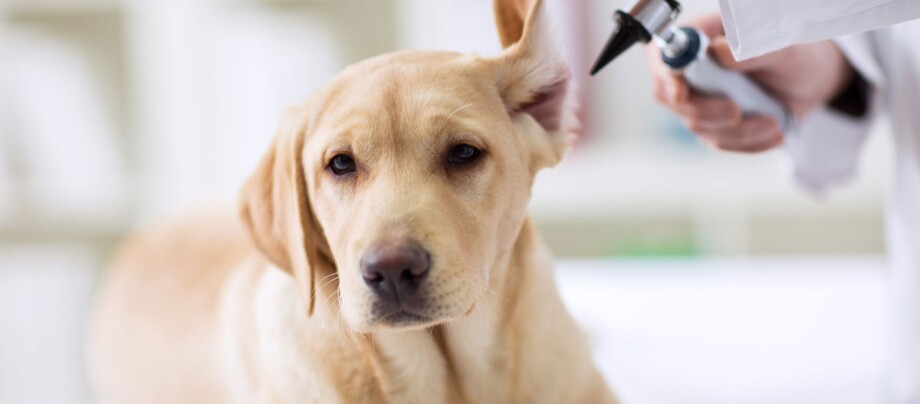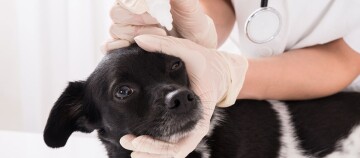Healthy Ears: How to Properly Take Care of and Clean Your Dog’s Ears!
07.10.2022 - Reading time: 4 minutes

Regular ear care for dogs is an important part of the grooming routine and strengthens the bond between you and your animal companion. Touching, cleaning and intensively examining the ears should become a pleasant routine for your dog. It is best to start practising this with your dog when it is still a puppy. Don't be afraid to make your dog's ear care part of your daily schedule, because even in a pack of dogs there are ear care rituals. The ears are important, sensitive sensory organs for dogs - a spread infection or an untreated parasite infestation can cause serious damage to the dog's hearing.
Find out here what good ear care entails and how to prevent possible ear diseases in your dog.
Interesting facts about your dog's ears
A dog’s ear consists of the outer ear, the middle ear and the inner ear. The ears are extremely important organs for the dog. Dogs use them to communicate with each other, they provide orientation, stabilise their balance and indicate from which direction the exciting or dangerous sounds are coming: the voice or whistle, the delighted bark or the warning growl of a conspecific.

Your dog has far better hearing than you do and can hear both higher and lower frequencies. Healthy dog ears have good blood circulation and are clean inside.
Ear diseases in dogs: what you should know
As a rule, dogs’ ears have sufficient self-cleaning powers including: production of “earwax” (cerumen), fine protective hairs, good ventilation and blood circulation. However, due to the many different breeds of dog, the shape of our four-legged friends’ ears have evolved to such an extent that the natural cleaning mechanisms unfortunately do not always work well. This is where you have to be vigilant and sometimes do the cleaning yourself.
The most common ear diseases in dogs affect the outer ear, i.e. the pinna and the external auditory canal.
Dogs that are more frequently affected by ear problems include:
- Long-haired breeds with floppy and hanging ears
- Dogs with thick hair on the outer ear
- Allergic dogs (food allergy, environmental allergy)
Dogs with kinked and overhanging ears can develop poor ventilation inside the ears and a damp, warm climate in which germs, fungi and bacteria can thrive. The ear canal is usually too narrow in hanging ears, enabling dirt and pathogens to settle there. In the case of dogs with very hairy ears – e.g. poodles – the hair obstructs the ear canal preventing the wax from flowing out naturally and the ear itself from being properly ventilated. As a result, inflammations can develop more quickly. Ticks, mites and other parasites thrive in this kind of “protected” environment.
Ear infections in dogs
Once the ears of your four-legged friend smell unpleasant and dark secretion adheres to the inner sides or the outer ear canal is raised and reddish, it is very likely that it has an ear infection (otitis).
You should also look out for the following symptoms:
- It frequently scratches its ear or inside its ear
- It rubs its head/ears on the carpet
- It often holds its head in a tilted position, sometimes shakes it
- It is anxious about being touched on its ears
- It howls
- It is restless or even aggressive
Never treat your pet’s infected ears yourself or with “home remedies” – leave the treatment to a vet.
Causes of ear diseases in dogs
This is what you should look out for:
- Awns are the spiked tips of tall grass where seeds ripen. In summer, awns can easily get caught in inside dogs’ ears and penetrate to the eardrum. This can cause great pain to the dog and can even damage the eardrum. Once awns have penetrated deep inside a dog’s ear, the only option is to go to the vet.
- Ear mites are tiny parasites that can attach themselves to the outer ear and around the edges of the ears. They feed on skin scales and earwax. Ear mite infections tend to be very itchy and contagious, which means that all pets in the household will need to be treated. You can recognise a mite infestation by a brownish-black ripple in the pinna of the ear and on the edges of the ear. It is essential to consult a vet, who will prescribe a special cleanser and mite-killing ointment. Look out for ticks in the ear at the same time and remove them immediately with a tick hook.
- Environmental and food allergies in dogs regularly cause ear problems. The symptoms (itching, pain) can be alleviated by painkillers and anti-allergic drugs provided by the vet.
Cleaning your dog's ears: how to do it properly
Prevention is the best medicine for dogs’ ears. Since ear diseases always require veterinary treatment, prevent them from happening in the first place.
Inspect long-haired dogs with folded or droopy ears daily after walking.
If your four-legged friend’s ears do not display any abnormalities, then the self-cleaning protective powers of your dog’s ears are in perfect working order and should not be interfered with by any cleaning actions.

Nevertheless, some dogs’ overproduce earwax (cerumen) in their ears, which can result in certain health risks long term, such as possible blockage of the ear canal and ear infections. It can also attract ear mites.
Clean your dog’s ears and remove excess earwax, preferably on a weekly or monthly basis.
The following methods are suitable for this purpose:
- A cotton cloth (lint-free) dipped in warm water and wrapped around your index finger. Gently run it over the inner ear, several times if necessary.
- Special ear cleaning products (e.g. Epi-Otic). Once instilled into the dog’s ear and carefully massaged in from the outside, they dissolve dirt and debris after a certain amount of time. After this application, let your dog shake himself vigorously to get rid of any loose particles.
- Special ear cleaning wipes for dogs. These wipes are enriched with additional essences such as aloe vera and provide intensive care for your dog’s sensitive ears.
Cotton buds are an absolute no-go when cleaning your dog’s ears. You risk damaging your dog’s eardrum or pushing earwax and debris deeper into the ear canal.
Since dogs are very sensitive around their ears and don’t like to have their ears cleaned, it requires helping hands, patience and coaxing. Don’t forget the treats as a reward.


